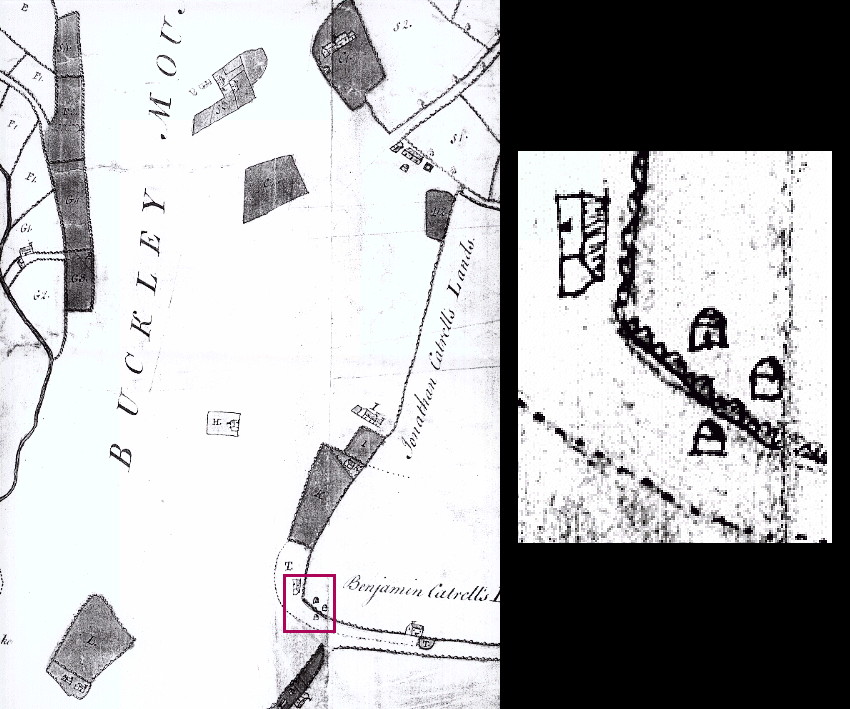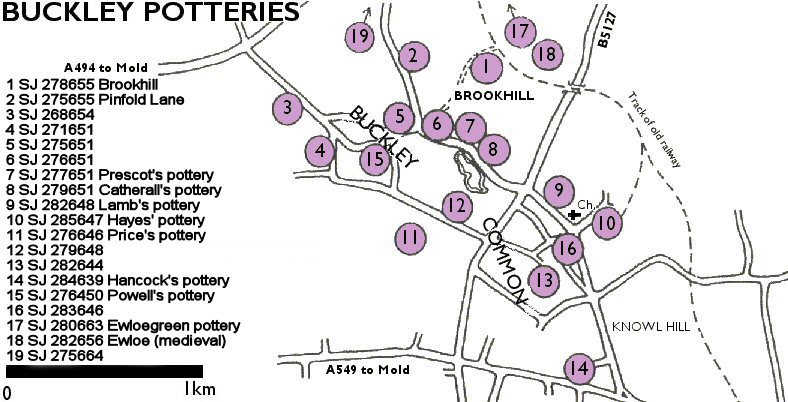The earliest known production site in the Buckley area is at Ewloe (Figure 4, no.18). A total of 938 sherds of pottery and 161 tile sherds were found while fieldwalking. Of these, there are 129 definite kiln waster pottery sherds and 58 tile wasters (Harrison and Davey 1977, 92). The bodies are mainly gritty, highly fired white and grey ware with green and brown glazes which compare closely with excavated examples from Chester. Some of the sherds bear evidence of a brown/red slip beneath the glaze (Davey 1976, 27). Trial excavations of anomalies evident during a magnetometer survey produced one sherd of 13th-14th century redware, 60 sherds of 14th and 15th century Ewloe type wares, 146 sherds of 16th century thin, dark reddish-brown wares and 500 sherds of 18th and 19th century Buckley ware (Weetman n.d.). There was no evidence of any kiln structure. The major products were jugs, large storage vessels and roofing tiles.
In the 16th century, there was a change in the structure of domestic life in the British Isles. This change can be linked to a series of economic and cultural trends throughout north-west Europe (Gaimster and Nenk 1997, 171) and it is particularly noticeable in the increase in pottery production at this time. Expanded trade with the continent brought in imported pottery and new ideas in eating and drinking. The traditional medieval domestic wares of wood, leather and metal were replaced by pottery and the simple ceramic forms of the medieval period expanded into many new wares to supply a growing domestic market. Small potting communities established themselves in areas which had suitable raw materials; clay, fireclay, fuel, water and lead.
In the Merseyside area, suitable clays and fuels existed on the coalfields of south Lancashire and in north Wales. Cottage potters built domestic kilns to serve the local markets around Liverpool and Chester. Documentary and excavation evidence have established that pottery production was well developed in the region by the late 16th century. This is discussed further in Appendix 2.
By the early 17th century, a group of cottage potters had settled around Buckley Mountain where they exploited the suitable supplies of clay, opencast coal and nearby sources of lead. Water transport was available on the Dee Estuary, down the hill from Buckley. They established encroachments on Buckley Common and utilised the wide range of clays found in the region. Red boulder clay, the most common raw material, was often mixed with a lighter buff-coloured clay to produce the domestic pottery. White clays were used in the production of clay tobacco pipes. Cooking pots and saggars were made from fireclays.
Documentary evidence is unfortunately lacking for the peak periods of production in Buckley at the end of the 17th century. The information that is available dates from the 18th century (Davey 1976, 16). An estate map entitled The Lordship of Ewloe 1757 gives acreages, land values, names of occupiers and buildings drawn in perspective. This map clearly illustrates the location of kilns on Buckley Common (D/GW/651 Flintshire Record Office) [see Fig. 3]. Other maps from the Gwysaney Estate covering the years 1750-1781 provide information about names of occupiers, encroachments on Buckley Mountain, location of pottery kilns (Flintshire Record Office). It is interesting to see how the encroachments were placed around the edge of the Common, with a few scattered in the centre. The earliest account of clay digging is found in the Gwysaney estate records from 1759.
'For cash received from Benjamin Codrell and others for clay raised in the Ewloe Lordship in the year 1757: £5.2s. 6d.'
The accounts after 1783 are more detailed, listing names and quantities of clay (Messham 1956, 32).

Figure 3: Estate map The Lordship of Ewloe 1757, detail inset shows three kilns
A series of excavations and field surveys has identified 19 pottery production sites ranging in date from the medieval site at Ewloe (site 18) to the closure of the last pottery in 1946 (Davey 1976, 16). The earliest post-medieval site is at Brookhill (site 1), which was excavated over a period of about 20 years by James Bentley. In total, twelve possible kilns were identified, most filled with ash, coal dust, kiln furniture and wasters (Amery and Davey 1979, 51). The site has been dated by the clay tobacco pipes found throughout the excavation. The earliest pipes date from c. 1640 and came from Chester. Local production was established by the 1660s, the most important pipe maker being Thomas Heys, who was making pipes between 1695 and 1720 (Higgins 1983, 50). Activity on the site was from the 1640s to 1720. The earliest wares, 1640-1660, include complex slip-decorated thrown bowls executed in both sgraffito and trailing techniques, porringers with press-moulded handles, a female figurine and large tripod cooking vessels (Davey 1987, 95). Sgraffito wares, early figures and moulds are not significantly present in Staffordshire at this time, which suggests that the influences need not have been in one direction. The sgraffito ware from Brookhill will be examined in depth in later sections.
The site of Pinfold Lane (site 2) was excavated by Bentley and Harrison between 1972 and 1974. Most of the finds date from 1690-1720. While the kiln furniture and clay tobacco pipes are similar in form and fabric to those from the 1690-1720 layers on the Brookhill site, the pottery is noticeably different. The method of decoration and style of slipwares and press-moulded wares varies between the sites. Pinfold Lane has none of the crudely decorated slip-trailed hollow-wares which occur at Brookhill. Green slip-decorated and jewelled vessels only occur at Brookhill. Bowls with simple slip trailing round the top of the rim are restricted to Pinfold Lane. All the mould fragments are in a fine, pale, dense clay, not usual in Buckley, and may have been purchased or supplied from elsewhere. There are mottled ware tankards and bowls from both sites, but Pinfold Lane has a wider range of bodies and slip decoration. Both sites produced a large collection of black glazed wares (ibid, 95-97).

Figure 4: Buckley potteries (after Amery and Davey 1979, 50) showing site name and grid reference.
Prescot's pottery (site 7) was excavated by Barton in 1954 and provided the first evidence for a production site in Buckley. Although the site of the kiln was not located, pottery and kiln furniture of c. 1740-1803 were recovered. The ware types include slip-decorated bowls and dishes, posset cups, black and brown glazed fineware, black glazed coarseware, salt glazed stoneware (Barton 1956).
The site of Hancock's pottery (site 14) was excavated in 1974/5 when part of the pottery dump was sampled ahead of road building. This was one of the major production sites in Buckley and operated from 1790-1886. Documentary records show the peak production was in c. 1803 followed by a general decline. A large quantity of domestic and industrial pottery and stoneware was recovered (Davey 1976, 25).
© Internet Archaeology
URL: http://intarch.ac.uk/journal/issue16/1/ch2.2.html
Last updated: Wed Mar 24 2004